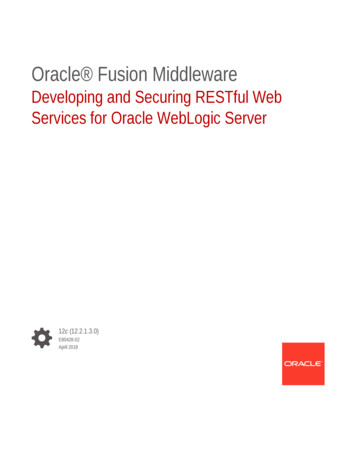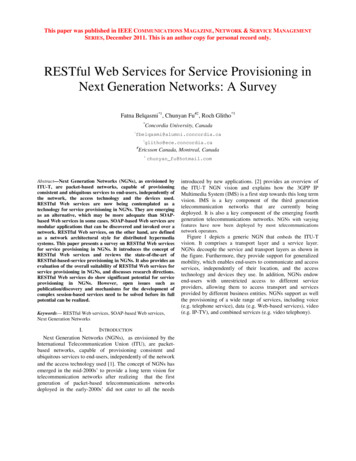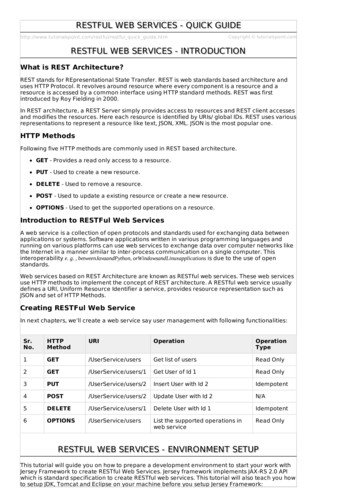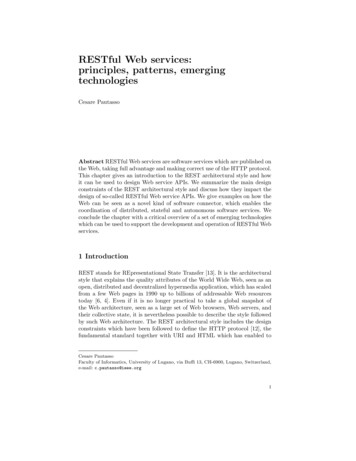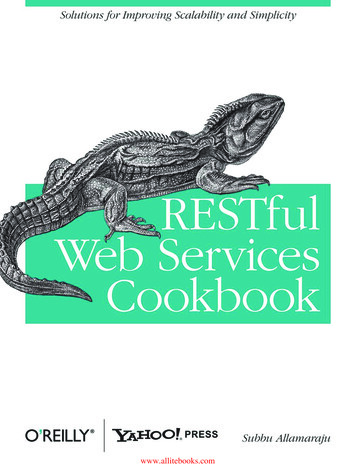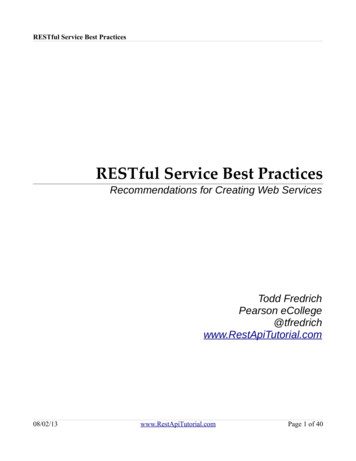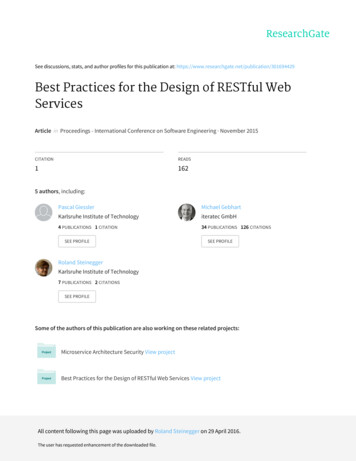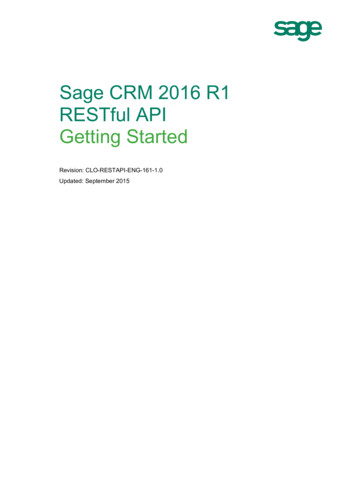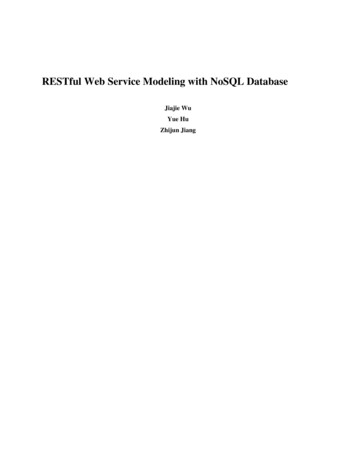
Transcription
RESTful Web Service Modeling with NoSQL DatabaseJiajie WuYue HuZhijun Jiang
Table of Content1. Preface .32. Acknowledgements .43. Abstract .54. Introduction .65. Theoretical Bases and Literature Review .75.1 SOAP based Architecture .75.2 REST: Resource-oriented Architecture .85.3 RESTful Web Service with Node.js and MongoDB .96. Hypothesis .97. Methodology .108. Implementation (refer to source code in appendix) .109. Design Document .119.1 Introduction .119.2 System Overview .119.3 System Description .129.4 Conclusion .1610. Data Analysis and Discussion .1611. Conclusion and Recommendation .2112. Bibliography .2213. Appendex .23
PrefaceThe Representational State Transfer (REST) style Web Service is lightweight and becomes popular:major Internet companies such as Google, Amazon, and Yahoo have all published REST APIs. Wepropose an approach using Node.js with MongoDB as database. Therefore, we will implement theRESTful Web Service using Node.js and generate different workload to measure performance of thesystem. We illustrate how we model a Web Service with a Recipe Website. The conceptual model ofcomment operation will be showed in this paper.
Acknowledgements:The authors would like to thank Irum Rauf, Anna Ruokonen, Tarja Systa, Ivan Porres, and Dept. ofSoftware Systems Tampere University of Technology, Tampere, Finland and Dept. of InformationTechnologies Abo Akademi University, Turku, Finland. Finally and most importantly, we would like tothank Professor Wang for his explanation and instructions during the project.Abstract:
Representational state transfer (REST) architecture is now widely used. RESTful architecture enablesweb service exhibit its functionality in the exposed resources. To build a Web Service with extensiblescalability, we investigate some architecture styles and modeling method. This paper uses RESTful WebService to build a conceptual and behavior model of a recipe website and measure the performance ofWeb Service components.
I. Introduction:With the emergence of cloud service, nowadays a web-based organization need to store and access datafrequently in a distributed system. In production environment, it is essential to integrate data with theexistence of heterogeneity in platforms, programming languages and data structures. In order toefficiently organize and utilize the distributed system, it is important to design a Web Service architectureadaptive to the cloud environment.Web services can be developed in a Remote Procedure Call (RPC) manner or as aRepresentational State Transfer (REST) style. The RPC-styled web service is operation centric. It exposesits functionality in the operations advertised on its interface. The main mechanism behind RPC ismessage passing: a client sends a request message to a server with parameters for a certain procedure. Theserver execute the procedure and sends back response to the client. Simple Object Access Protocol(SOAP) is a successor of RPC and has been a well-accepted architecture style. Despite its extensibilityand independency, verbosity of SOAP resulting from envelope wrapping becomes a major obstacle forperformance when data exchange becomes more and more frequent in a distributed system.On the other hand, the Representational State Transfer (REST) style Web Service is lightweightand becomes popular: major Internet companies such as Google, Amazon, and Yahoo have all publishedREST APIs. REST web services follow a different architectural style and thus require different designphilosophy and techniques. The REST style architecture is resource oriented and exhibits its functionalityin the exposed resources. A RESTful web service is designed such that its interface offers addressability,connectivity, uniform interface and statelessness. The advantages of RESTful systems is that they arehighly scalable and highly flexible. Because the resources are accessed and manipulated using the fourHTTP verbs, the resources are exposed using a URIs, and the resources are represented using standardgrammars, clients are not as affected by changes to the servers. Furthermore, RESTful systems can takefull advantage of the scalability features of HTTP such as caching and proxies.In order to specify how resources and methods of composite REST web service are mapped toresources, it is important to model a composite RESTful web service for its static and dynamic behaviorusing class diagram, activity diagram and state machine diagrams. In this model, the addressabilityfeature of REST requires that any relevant information related to the service is exposed as a resource.Each resource has one or more unique addresses and has one or more representations that are accessibleremotely. In order to achieve connectivity resource representation should contain links to other resourcessuch that the graph formed by resources and their links is connected. For a uniform interface, all resourcesare manipulated using the same set of methods. In the case of HTTP web services the methods are GET,POST, PUT and DELETE.
The paper is organized as follows. Section 3 gives an overview of Web Service under the cloudenvironment and detailed modeling using REST style architecture. Section 4 specifies why Node.jsframework and MongoDB are suitable to implement a RESTful Web Service. Section 5 provides detailsof how to measure performance of the Web Service.III. Theoretical Bases and Literature ReviewA Web Service defines the communication rules over a network through programmatic interface usingstandard protocols. A well-designed Web Service ensures that service requester and provider canexchange data efficiently over the internet. Since the two entities are often in two different softwaresystems, heterogeneity and interoperability become important issues. In this context, Service-orientedArchitecture (SOA) is a feasible solution because it provides abstraction from underlying complexity andindependency from implementation technologies. The Simple Object Access Protocol (SOAP) basedframework with XML and WSDL standards has been a popular SOA architecture. This framework hasthe advantage of loose coupling, seamless interoperability, and good scalability.3.1 SOAP based ArchitectureFigure 3.1 Communication Process in Web ServiceSource: RESTful Web Services: a Solution for Distributed Data IntegrationSOAP was designed as an object-access protocol in 1998 by Dave Winer, Don Box, BobAtkinson, and Mohsen Al-Ghosein for Microsoft, and is now maintained by the XML Protocol WorkingGroup of the World Wide Web Consortium. Figure 3.1 shows a set of Web Services, based on WebServices Description Language (WSDL), Universal Description Discovery and Integration (UDDI), andSOAP. As shown in the graph, the server provide SOAP based services that are published on the registryUDDI. The client shall specify request with criterion and search for a corresponding service on the UDDI
registry. The client uses binding operation to connect to the server and request for remote service usingSOAP APIs.Since SOAP is a messaging protocol with a set of constructing rules, it is not efficient to serializeand deserialize information into SOAP message. Besides, since clients cannot obtain useful informationdirectly from URI, it is also impossible to take advantage of proxy and cache server. In sum, redundantinformation and complexity of this framework result in a less satisfying performance when there is moreand more frequent information exchange nowadays.3.2 REST: Resource-oriented ArchitectureDocumented by Roy Fielding, Representational State Transfer (REST) is a Resource-orientedArchitecture (ROA). Resource can refer to any mapping to a set of entities in a service interface.Specifically, a resource need to be referable with an address. The address is a Uniform Resource Identifier(URI) to location the resource. Representations are any valuable information about the states of a resource,in the form of bytes stream and metadata.A REST architecture is defined by four attributes:·Addressability: As mentioned above, any resource can be retrieved using URI so that thearchitecture no longer needs an extra resource locating mechanism such as UDDI.·Connectedness: Representation contains hyperlinks to other resources so that state transfer canbe implemented.·Statelessness: Server does not remember the state of applications so that each request shallcontain all necessary information to complete the service.·Uniform Interface: Resources are manipulated using the standard HTTP methods.A RESTful Web Service following the four attributes is well adaptive to the distributed trendnowadays. Addressability contributes to easy accessibility, which is important under frequent dataexchange in a cloud environment. The statelessness feature contributes to higher reliability in thatindependency of each request so that failure of one request has less potential influence on others. Sincethe no application state needs to be recorded by the server, the server can simultaneously server morerequest, which can improve the scalability of the whole system.3.3 RESTful Web Service with Node.js and MongoDBWhile the previous research implement RESTful Web Service with Django framework and Ruby on Rails,we propose a different implementation approach using Node.js with MongoDB as database. The detailed
reasons why Node.js platform and MongoDB are better choices in a cloud environment are stated asfollows.Node.js is a cross-platform runtime environment. It was invented with event-drive model adaptedto the Web. The platform uses a non-blocking I/O model and single-thread event-based loop. Under thismechanism, the thread will not be blocked while other operation is processing so that Node.js can keepmany collections alive while still severing incoming connections. This feature especially useful toaccommodate real-time Web application. Node.js is implemented with JavaScript because it has nouniform I/O API so that it could be designed with the non-blocking model. Node.js’ event loop does notneed to be called explicitly, instead any I/O related operation must use a callback so that the server couldproceed to deal with callbacks. While millions of connections can be handled simultaneously, Node.jsprovides a highly scalable platform.MongoDB is document-oriented NoSQL database designed for ease of development and scaling.While traditional database has rigid schema, MongoDB uses a BSON document. A BSON is a JSONstyle document that takes all data stored in a row that spans multiple tables of relational database andaggregates it into a single document. With this flexible data model, it is easier to distribute resultingdocument and improve performance. Furthermore, MongoDB has an auto-sharding mechanism toredistribute data and handle load balancing. Data migration is flexible so that bandwidth is required at aminimum level and the whole system has higher scalability. Besides, MongoDB's ability to storeJavaScript objects natively saves time and processing power. Instead of a domain-specific language likeSQL, MongoDB utilizes a simple JavaScript interface for querying. Looking up a document is as simpleas passing a JavaScript object that partially describes the search target. In conclusion, MongoDB is notonly suitable for distributed system, but also well adaptive to the Node.js based RESTful Web Service.IV. HypothesisThe goal of our work is to implement a RESTful Web Services using Node.js and MongoDB. Node.jscombined with a document database and JSON offers a uniform JavaScript development stack. Wesuppose this lightweight framework cloud comply with the features of a RESTful Web Service and wouldlead to a satisfying performance. Our hypothesis is that the response time of service shall increase linearlywith the increase of workload intensity. The increasing speed of response time is a measurement for WebService scalability so that slower increasing speed indicates a higher performance in system scalability.
V. MethodologyIn this section, we illustrate how we model a Web Service with a Recipe Website. The conceptual modelis shown in Figure 4.1. “Search” is a POST operation while “Details” is a GET operation. The “Comment”is a collection resource that has four resources: “getComment()”, “addComment”, editComment, and“deleteComment”.Figure 4.1 Conceptual Model for Recipe Web SiteWe use MongoDB as our database. The input data includes recipe details. Input data are manuallycollected and input into MongoDB. According to the functionality of our front end project, we will have 3tables which are “Search entries”, “Details”, and “Comments”. They are related, details table has aforeign key points to IDs of entries in “Search entires”. The “Comments” table has a foreign key pointsto IDs in “Details” table. When web service receive a HTTP call, it will retrieve data from MongoDB,and then send back to front end in JSON format.We have implemented the RESTful Web Service using Node.js and generate different workloadto measure performance of the system. Our major measurement calibrator is response time. If the averageresponse time does not increase significantly with increasing workload, we can expect the system to havea satisfying scalability.
We use Apachebench to generate request and measure performance of our web service.Apachebench is a single-threaded command line computer program for measuring the performance ofHTTP web servers. We can set number of requests, concurrency level, request type (get, post, put, delete).Since post is a most representative request with more user interaction, we have tested the performanceusing one of the post type API: /search. The input is a JSON file including search word. We can setApachebench with -p as POST type request and -T “application/json” to define the input type. A samplecommand of Apachebench is “ab -n 1000 -c 200 -p data.json -T 'application/json' s.com:3000/search”.VI. ImplementationSource Code – Please refer to source code in appendix.Design document6.1. IntroductionThis software design document describes the architecture and system design of building a RESTful webservice modeling with Node.js and MongoDB. Our goal is to try to study a new cloud web servicecomputing technique and build a software system based on what we have learned.6.2. System OverviewThis software system our built is website provide a service about food recipes sharing and commenting.For the front-end side, we use a new language called Ember.js which a new framework for creating webapplications; for the back-end side, we use node.js which is a platform for building fast, scalable networkapplications; for the database, we use MongoDB which is an open-source document database with Agileand Scalable feature. Therefore, the software system we built is combined three new cloud webtechnologies which make our system faster and scalable.
6.3. System DescriptionStartUsernamePasswordInputLog inNoValid?Log outYesiFood HomePageLogin ScreenHome screenOur system starts with a login screen which requires user to input username and password. Afteruser login, the system will process the input information and validate it, if it is correct then process nextstep; if not, system will show a username or password error message and stay in the login screen. Afterlogin success, system will route to a homepage called “iFood Home”. In the home page screen, somedish images is showed in a slide windows and the system will provide three functions: create a newrecipe by user, input a keyword to search existed recipes in system and display recipe category items inscreen in order to let user do the quick search. Following is the three functions detail:
iFood HomePageClick addnewType inSearchwordClick acategoryAdd newrecipeShow resultShow chosencategoryDetail infoaboutrecipeChoose adishShow dishdetailCreate New Recipe ScreenSearch Keyword ScreenCategory Quick SearchThe Create New recipe function: when user clicks the “ new” button in the home page, systemwill route user to an “Add New Recipe” page. In the page, user is required to input the details of a recipe:name of the recipe, image URL which for showing a dish, choose a category type which can add more,
Ingredients and cooking method which can add more steps. After inputting, user click the save button,then system will send those information to backend and create a new record and save it to database.The Search keyword function: when user input a keyword on the search field in the home screen,then system will get the keyword and perform a query search in database; if it return any results, thensystem will display a result screen which shows match dishes with basic information, if user click on ofthem, system will show a dish detail screen contains all the detail information of the dish. The categoryquick search function: there are some categories showed in the home page screen, user can click on ofthem, then system will perform a database query search based on the category keyword, and then displaya result screen just like the search keyword function.Show dishdetailClick addcommentClickcommentClickdeletecommentAdd commentand rateShowcommentDeleteCommentdetailsDelete a Comment ScreenRecipe Detail ScreenAdd New Comment Screen
In the recipe detail screen, there is a comment part which can let user see all existed commentsabout the recipe, let user add a new comment and delete the comment which created by the current user.For the comment part, system provides three functions: add a new comment, show comments and delete acomment. The follows will show how they work:Add a new comment function: there is a comment part in the bottom of detail page, when userclick the “Have comment?” field, system will shows a field to let user ranking which is up to five starsand adding a comment for the recipe. After user click “Submit Comment” button, system will send tobackend and create a new comment record to save it in database and system will refresh the commentscreen to show the all comments including the one user just created. Show comments function: whenuser click the “Comments” field, system will perform a database query search, the comment partial screenwill show all the comments of the recipe if there is any results return. Delete comment function: whenuser click the “Comments” field, user will see all comments including the one which user created, andthere is a delete button showed to let user to delete the comment. After user click the delete button,system will perform a database delete record query to remove the comment and system will refresh thecomment screen to show the all comments except the one user deleted.6.4. ConclusionBefore start programming, we have considered other RESTful programming language technique, suchRuby on Rails or Django. Because our goal is to build a faster and scalable cloud web service computing,so we choose a new technique Node.js and MongoDB in the backed side, and also think about theprogramming language homogeneity in order to perfume a fast way coding, we choose Ember.js as thefrontend side language. We will also do some benchmark tests to show how those three new techniquescombine together beat the old web service technique like SOAP.Flow Chart – Please refer to program flow chart in appendix.
VII. Data Analysis and DiscussionWe deployed our project on Amazon Elastic Compute Cloud (EC2). The instance type is t2.micro withhigh frequency Intel Xeon processors operating at 2.5GHz with turbo up to 3.3GHz. The workload isgenerated on an Intel Core i7 processor operating at 2.0GHz with 8GB RAM. Both machines run Ubuntuoperating system.Experiments are conducted with different concurrency level. Experiments of each concurrencylevel is repeated for ten times. As shown in the appendix section, the Apachebench returns detailedsimulation result, while we mainly take two metrics into consideration: response time and requests persecond. Request per second is calculated as total number of requests divided by total test time. The totaltest time might also include interval time if multiple request groups are sent, while response time onlyincludes the connecting time and request processing time. The two metrics can provide basic performancemeasurement for our web service. We have conducted experiments on both Amazon EC2-host webservice and localhost web service.Figure 7.1 shows the relationship of concurrency and response time for EC2-host RESTful webservice. Concurrency level is measure as number of requests sent simultaneously. Response time ismeasured in milliseconds. We can see that with increasing concurrency the response time also increaseslinearly, which supports our hypothesis. We have also conduced regression on concurrency and responsetime. Table 7.1 shows the regression result. The multiple R is 0.923, which indicates a strong linearrelationship. The coefficients for intercept and x are significant: 74.32 and 0.63 respectively. We canconclude that under concurrency level from 10 to 80.140RESPONSE TIME (MS)1201008060402001020304050607080CONCURRENCY LEVELFigure 7.1: Response Time for EC2-host RESTful Web Service90
Regression StatisticsMultiple R0.923263116R Square0.852414781Adjusted R Square 0.850522662Standard idualTotal17879SSMS16732.85952 16732.859522897.090476 37.1421855919629.95FSignificance F450.50820943.80989E-34Coefficients Standard Error t StatP-value Lower 95% Upper 95% Lower 95.0% Upper 95.0%74.321428571.501686142 49.49199 1.12E-60 71.33180112 77.31105602 71.33180112 77.311056020.6311904760.029737817 21.22518 3.81E-34 0.571987031 0.690393922 0.571987031 0.690393922InterceptX Variable 1Table 7.1: Regression Result on Concurrency Level and Response TimeFigure 7.2 shows how requests per second changes with increasing concurrency level. Whenconcurrency level is lower than 30, the number of requests per second increases because the server hasnot been fully used. Then after concurrency level 40 the number of requests per second decreases andbecomes relatively stable afterwards. The trend also indicates good scalability of the web service underthese concurrency levels.500REQUEST PER SECOND40030020010000102030405060708090CONCURRENCY LEVELFigure 7.2: Requests per Second for EC2-host RESTful Web ServiceWe have also tested with higher concurrency levels for EC2-host web service, however, the resultis not stable with high standard deviation. One reason is that the web service is based on cloud Amazonplatform and we are using the free basic service model that might have limitation on connection such asnumber of simultaneous request. Therefore we also conduct performance test with localhost web servicefor higher concurrency level. In this case the effect of network latency would also be eliminated.
35RESPONSE TIME CY LEVELFigure 7.3a: Response Time for Localhost RESTful Web Service140RESPONSE TIME (MS)12010080604020050100 150 200 250 300 350 400 450 500 550 600 650 700 750 800 850CONCURRENCY LEVELFigure 7.3b: Response Time for Localhost RESTful Web ServiceRegression StatisticsMultiple R0.972606131R Square0.945962687Adjusted R Square 0.941050204Standard Error11.20934556Observations13InterceptX Variable 1ANOVAdfRegressionResidualTotalSSMSFSignificance F1 24195.43629 24195.43629 192.5630439 2.57854E-0811 1382.143706 125.64942781225577.58Coefficients Standard Errort StatP-valueLower 95% Upper 95% Lower 95.0% Upper 95.0%7.9945366754.52920309 1.765109 0.10525329 -1.97417211 17.96324546 -1.974172114 17.963245460.1584456060.011418097 13.87671 2.5785E-08 0.133314544 0.183576668 0.133314544 0.183576668Table 7.2: Regression Result on Concurrency Level and Response Time
From detailed result in appendix we can see that connection time is nearly zero and response timeis dominated by request processing time. Figure 7.3a and 7.3b shows the relationship between responsetime and concurrency level for localhost RESTful web service. Since the pattern is different forconcurrency level below 100 and above 100, we have plotted two figures. Figure 7.3a shows that thelinear relationship is strong when concurrency level is below 100, while according to Figure 7.3b, therelationship is not as stable as in low concurrency cases. However, as the regression result shown in Table7.2, the multiple R is 0.97 and the linear correlation is still strong. Again this supports our ONCURRENCY LEVELFigure 7.4a: Requests per Second for Localhost RESTful Web Service50004000REQUESTS PER SECONDREQUESTS PER URRENCY LEVELFigure 7.4a: Requests per Second for Localhost RESTful Web Service850
Figure 7.4a and 7.4b shows the relationship between requests per second and concurrency level.Again we used two figures for concurrency level below and above 100. When concurrency level is lowand the server is not fully utilized, the number of requests per second increases when concurrency levelincrease. After concurrency level increases above 100, the number of requests per second keeps relativelystable from concurrency level 100 to 600 and decreases when concurrency level increases above 700.Multiple reasons account for the decrease in number of requests per second. First, when wegenerate high volume of simultaneous requests, the memory might be overloaded and the system startsswapping into the paging files, this is especially likely as we generate and process request on the samemachine, so that when request volume is high, the performance of web service will naturally decrease.Second and more important, the Apachebench is a single-threaded program. Since it specifies thewaiting time of requests, it is likely that Apachebench puts requests in a queue for waiting. Withoutparalleling Apachebench instance, the requests are not really concurrent. The deviation might benegligible at low concurrency level, however, when concurrency level is high, the error leads to a lessaccurate result. Specifically, since the number of requests per second is calculated as total number ofrequests divided by total test time, the longer than real test time (including requests queueing time) resultsin a lower number of requests.VII. Conclusion and RecommendationRESTful Web Service is a lightweight architecture. Implemented with Node.js and MongoDB, it is moresuitable for real-time Web applications. Our performance test of EC2-host RESTful web service andlocal-host web service provides insightful information about RESTful web service performance. Althoughthe measurement mainly focuses on software architecture bottleneck, the results supports our hypothesisof linear relationship between concurrency level and response time, which indicates good scalability ofour RESTful web service.Although REST architecture implemented with Node.js is efficient and scalable, the bestimplementation of web service highly depends on the function of a web-based application. Since Node.jsis synchronized, a callback function is continuously monitoring I/O signal. If for a certain application, asingle general request involve complicated logical flow, the procedure will be disrupted by incominginput, which might cause potential troubles in development and runtime, so that this mechanism is notsuitable. Generally, the asynchronous mechanism is more suitable for real-time Web application withhigh concurrent requests and simple logic flow.
IX. Bibliography:[1] Thomas AmbÄ
The goal of our work is to implement a RESTful Web Services using Node.js and MongoDB. Node.js combined with a document database and JSON offers a uniform JavaScript development stack. We suppose this lightweight framework cloud comply with the features of a RESTful Web Service and would lead to a satisfying performance.
